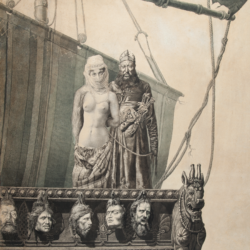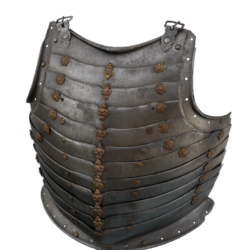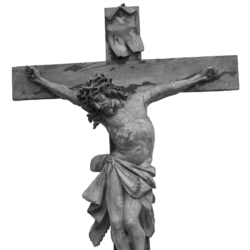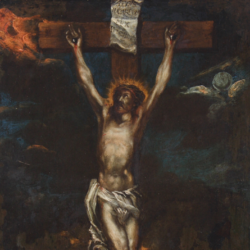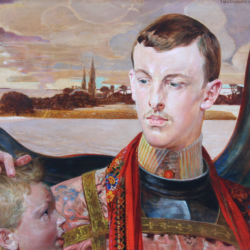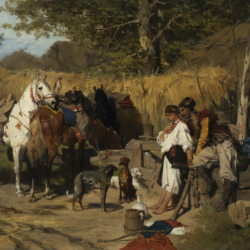
Dionysian Sienkiewicz II (Dionysus and Nietzsche)
When showing the suffering bodies, Sienkiewicz adheres to the mystic-romantic line: the body is the way to save the soul and to enhance the (national) spirit. Konopnicka seems to be discussing this although the vitalistic theme woven into her text suggests the influence of the conceptions originating from modernism streaked with Nietzscheanism. Particularly in Zieliński’s interpretation, the Dionysian, if not Nietzschean, character becomes entangled in mystic interpretations; it overlaps with them. The figure of Samuel Zborowski, as described by Rymkiewicz, is thoroughly Dionysian: insane, extreme, anti-Christian, going to certain death, fragmented and cut, and then in some way resurrected, not in the soul, but rather in his body. Even this sewing together of the parts of the body of the Polish knight by the Zebrzydowski sisters alludes to the female Dionysian rituals, to the attachment of women to Dionysus, to their maintenance of his cult. Rymkiewicz is Dionysian, but what about Sienkiewicz? Can we find similar notes in his protagonists? He seems too focused on Catholicism to take other religions and cults seriously. Tadeusz Zieliński, an eminent world-famous expert on antiquity, regrets that Sienkiewicz did not know much about the culture of ancient Greece. This opinion can be confirmed when we read Sienkiewicz’s novels and Greek tales, which only superficially reflect the historical realities – artificial, pre-textual, light, if not trivial. However, the scholar can see a certain way out of this situation – religious syncretism. According to Zieliński, the Holy Mother absorbed virgin-goddesses and mother-goddesses of the antiquity. Combining Catholicism with the love of his homeland, the Polish Catholic adds a new sacrament to his religion: the sacrament of Mother-Earth. The symbol of Mother-Earth is the connecting link between antiquity and Christianity. Zieliński buries the gulf between the cults of antiquity and Christianity. The example of Sienkiewicz’s Ligia shows the different forms the religious attitude towards the world could take throughout various historical epochs. If the heroine had lived three hundred years later, she might have fought to defend the statue of Demeter in Eleusis and her opponents would have been the hordes of Alaric, Goth, and – “what a shame to say” – as Zieliński adds the point – of a Christian, setting fire to the sanctuary of the goddess. As Michał Luśnia (actually Kazimierz Kelles-Krauz) ironically and perversely wrote, Sienkiewicz’s Quo Vadis can be considered a revolutionary novel; the fight between Christians and pagan Rome prefigures the clashes between the proletariat and the defenders of capitalism.[1]
Since Sienkiewicz did not write a novel about the barbarian raids of Rome, and he was far from any revolutionary associations, we have to stick to what we are left with: Tadeusz Zieliński’s attempt at the Dionysian reading of Sienkiewicz’s historical works. Is it legitimate? The answer to this question requires an analysis of the Nietzschean themes in Sienkiewicz’s work – the themes I understand differently than Maciej Gloger, yet this complex issue calls for a separate paper.[2] Let us assume, here and now, that in the case of some of Sienkiewicz’s heroes, such as Jeremi Wiśniowiecki, who were able to suspend their ethical obligations and were brave enough to give up on the rules of ethos, we can talk about the shadow of apparent Nietzscheanism (it is apparent because it was loosely linked to personal risk of the hero who was invoking higher sanctions). Nietzscheanism which does not lead in a straightforward way towards a healthy, beautiful, and peaceful life, as Zieliński would like to see it, but is the embodiment of violence. This violence is so strong and omnipotent that one of the researchers compared Prince Wiśniowiecki’s order to kill Khmelnytsky’s envoys to the state of emergency, as defined by Giorgio Agamben, and thus to a totalitarian situation: the sovereign, being beyond the law, proclaims its absolute reign or – just the contrary – the repeal of its rules. “The law constitutes the personal inviolability of an envoy, but only until the sovereign repeals this law on the territory that the sovereign controls.”[3] Incidentally, this episode in Sienkiewicz’s story resembles a fragment from Jan Kazimierz, Słowacki’s drama, where we can find a similar scene of violation of the envoys; Sienkiewicz’s scene resembles and reminds us of Słowacki’s work.[4]
The history of Polish literature has not so far seen anything inappropriate in an attitude streaked with cruelty, which in Słowacki’s writing is aesthetically softened with humor and the grotesque, modeled on Shakespeare, among others (Firlej, in response to the demands of the envoys replies with an allusion to The Merchant of Venice: “Why didn’t you demand a pound of flesh from each heart?”). Juliusz Kleiner, however, wants to interpret the grotesque convention of the drama in a clearly ideological context: “But when Khmelnytsky’s envoy arrives and demands that Jeremiasz [Jeremi Wiśniowiecki – G.B.] be given away, the drama heightens. We can feel the Polish knight, we can feel the hero in what old Firlej says.”[5] For the sake of clarity, let us add that in Słowacki’s drama, it is Mikołaj Koniecpolski, and not – as in Sienkiewicz’s text – Wiśniowiecki, who suggests that the envoy should be killed, and his head should be used to load the cannon.
Przypisy
- M. Luśnia [K. Kelles-Krauz], “Powieść rewolucyjna” [The revolutionary novel], Naprzód 1897, vol. 1, p. 6 (a substantial part of this paper was confiscated).
- Maciej Gloger sees Sienkiewicz’s Nietzscheanizm in the following manner: just like Nietzsche in his famous essay “On the Use and Abuse of History for Life” did not entirely condemn the history, Sienkiewicz was not its uncritical singer. “Both Nietzsche and Sienkiewicz are concerned with ‘a healthy dose’ of historical sense, which is supposed to ‘reassure’ and be the driving force” (M.Gloger, Sienkiewicz nowoczesny [Modern Sienkiewicz], Bydgoszcz 2010, p. 130). The parallel that was drawn here seems at least insufficient and based on a logical error. The fact that Nietzsche did not completely reject references to history does not bring him in any way closer to its apologists. Besides, in order to confirm this parallel, we would need to entirely re-interpret – and reject – the religious nature of Sienkiewicz’s world (in the providential-messianic spirit), which does not seem to have been the researcher’s intention.
- F. Mazurkiewicz, Opowieści nowoczesne [Modern Stories]. Katowice 2015, p. 128.
- It is possible that Sienkiewicz knew the scenes of the drama. A fragment of Słowacki’s drama, written at the end of 1841 has been preserved. It is mentioned by Józef Alojzy Reitzenheim in a monograph Juliusz Słowacki (Paris 1862); the preserved parts of the drama were published by Antoni Małecki (Pisma pośmiertne Juliusza Słowackiego [Posthumous works of Juliusz Słowacki], vol. 3, Lwów 1866: “Jan Kaźmierz. ‘Szczątek dramatu’ [Jan Kaźmierz: A fragment of the drama]). A columnist for the Czas magazine also noticed the similarity between Sienkiewicz’s novel and Słowacki’s drama: [b.a.] “Sienkiewicz and Słowacki,” Czas 1884, nr 48.
- J. Kleiner, “Słowacki. Dzieje twórczości” [Słowacki: The history of works], vol. 3: Okres ‘Beniowskiego’ [The Beniowski period], edited and with an introduction by J. Starnawski, Kraków 1999, p. 175 (the verse of Słowacki’s drama is quoted here after Kleiner).

